Celebrating 200 years of Frankenstein with a reading of the entire classic novel
200 years after Frankenstein’s publishing, the iconic novel is still being taught in many college classes.
(photo illustration/Katina Zentz)
August 28, 2018
University of Iowa faculty and students will read the entirety of Frankenstein aloud to honor the groundbreaking novel’s 200th birthday.
The reading will take place on Oct. 3 at 9 a.m. in front of the Old Capitol. Participants will read the novel in shifts, each slot 20 minutes long. If there is inclement weather, Russian Adjunct Assistant Professor Anna Barker said she plans to go inside the Old Capitol. People can still sign up to be readers on the book-festival website.
Barker has organized public readings of famous novels for a while now, such as *Don Quixote* in 2015. This year, she is doing Frankenstein in honor of the anniversary of its publishing.
Other events on the same day include a panel at 7 p.m. based on the books that the creature in Frankenstein reads to learn about humanity and a double feature by FilmScene of Frankenstein and Bride of Frankenstein starting at 9 p.m.
Aug. 30, 1797 was the day of Mary Wollstonecraft Godwin was born. However, she eventually became better known by her married name, Mary Shelley. She is the author of the book Frankenstein, which many people call the start of a new genre.
“The idea that a woman started the science-fiction novel is really cool,” UI sophomore Ryan Johnson said.
When Shelley started writing Frankenstein, she was only 19. The novel was published in 1818, marking this year the book’s 200th anniversary.
“It’s a book [that has] a remarkable longevity, not only a fabulous science-fiction narrative,” Barker said. “It was written by a brilliant young woman.”
Despite being 200 years old, Frankenstein has not been forgotten. In fact, the novel is one of the top books assigned in college courses.
“I am a professor of 18th-century romantic period British literature, so when I teach Frankenstein, it’s almost always in the context of the course on British romanticism,” Professor Eric Gidal said. “It also gets taught in the [general education] lit course a number of times, history of science-fiction courses. It gets taught in the context of 19th-century women writers.”
There are many reasons that it’s still taught today. The meaning of the story still resonates with artificial intelligence, genetic manipulation, and the responsibility of humans to their creations.
“There’s a lot of Frankenstein that’s universal, especially the creature’s perspective on what it means to be human,” Johnson said.
Shelley is not the only famous member of her family. She grew up in a time after the storming of the Bastille, which prompted many new political thoughts and ideas. Her father was William Godwin, a famous anarchist who advocated for abolishment of institutions, and her mother was famous feminist Mary Wollstonecraft, who wrote A Vindication of the Rights of Women.
“When I teach, I teach it in terms of those biographies,” Gidal said. “I teach it in terms of intellectual and cultural histories surrounding French Revolution, and I teach it in terms of the general questions that it asks and how the questions about human existence and how we see ourselves in the world arise.”



